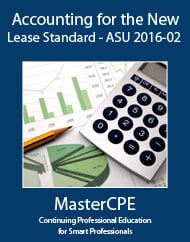Course Information
The New Lease Standard – ASU 2016-02 and Other Amendments
Course Information
| Title: | The New Lease Standard – ASU 2016-02 and Other Amendments |
|---|---|
| Category: | Accounting and Auditing |
| Field of Study: | Accounting |
| Course Code: | M228 |
| CPE Credits: | 4.0 |
| Price: | 34.95 |
Description
Description:
The purpose of this course is to review the changes made to lease accounting by ASU 2016-02, Leases, (as further amended by ASU 2018-01, Land Easement- Practical Expedient for Transition to Topic 842), and numerous other amendments, and to establish the principles that lessees and lessors shall apply to report useful information to users of financial statements about the amount, timing, and uncertainty of cash flows arising from a lease. Topics include a review of the new rules for lessees and lessors, the types of leases, how to account for the balance sheet, income statement and cash flows statement impacts of different types of leases, the implementation requirements, and more.
This course also addresses newly issued ASU 2023-01, Leases (Topic 842)- Common Control Arrangements, addressing the application of the lease standard to common control arrangements.
Delivery Method: Online Interactive Self Study
Level: Overview
Prerequisites: None
Advanced Preparation: None
Course Details
Category: Accounting and Auditing
Field of Study: Accounting
Passing Score: 70%
Technical Details: Accounting is a technical field of study.
For More Detail:
If you are unable to view PDF then right click the mouse and click save link as
Objectives
Objectives:
- Recognize a key change made to GAAP by the new lease standard
- Identify a type of lease that exists for a lessee under ASU 2016-02
- Recall a type of lease for which the ASU 2016-02 rules do not apply
- Identify some of the types of benefits a lessee can obtain from a leased asset
- Identify a threshold for a lease term to be considered a major part of an asset’s remaining economic life
- Recognize who an entity might not want to use the risk-free rate to compute the present value of lease payments
- Identify how a lessee should account for initial direct costs
- Recognize items that are and are not components of a lease term
- Recall the method a lessee should use to record interest expense on a lease obligation
- Identify some types of leases for a lessor
- Recall how a lessor should initially account for initial direct costs for a lease in certain instances
- Identify how a lessor should account for lease payments received on the income statement for an operating lease
- Recall how a lessor should classify certain cash receipts on the statement of cash flows
- Recognize how certain existing leases are accounted for on the implementation date of ASU 2016-02
- Identify how deferred income taxes will be treated for lessees under ASU 2016-02
- Recall the potential impact that the new lease standard might have on a lessee’s EBITDA and debt-equity ratios, and
- Recall the IRS rules as when an entity should and should not capitalize a lease for tax purposes.
For More Objectives:
If you are unable to view PDF then right click the mouse and click save link as
Profession
NASBA: Yes
QAS: Yes
CPA: Suitable for all CPAs
IRS: No IRS credit for Enrolled Agents.
Profession Identifiers: CPA

